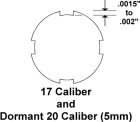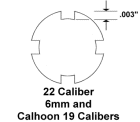

 The Accurate Reloading Forums
The Accurate Reloading Forums  THE ACCURATE RELOADING.COM FORUMS
THE ACCURATE RELOADING.COM FORUMS  Guns, Politics, Gunsmithing & Reloading
Guns, Politics, Gunsmithing & Reloading  Reloading
Reloading  increase in powder = corresponding increase in speed?
increase in powder = corresponding increase in speed?Go  | New  | Find  | Notify  | Tools  | Reply  |  |
| One of Us |
Clearly if you increase powder you will increase velocity but is it a linear equation? For instance lets say load A has 68 grains of powder and throws a bullet at 2300 fps now load B has 70 grains of powder and throws a bullet at 2400 fps is it a relatively safe assumption that load C at 72 grains would move a bullet at 2500fps? Thanks, John | ||
|
| one of us |
It is not a linear equation. As pressure increases, the powder burn rate changes. You could also get to a point where not all the powder is burnt in the barrel and some is burnt ahead of the muzzle, failing to add as much to the muzzle velocity as previous increases. There are too many variables and, if your interest is in muzzle velocity, the only way to be sure is to chronograph the loads. | |||
|
| one of us |
/ | |||
|
| one of us |
Gerard is right at some point you get very little increase. I was out playing with a load over a chronograph and a 2gr increae only amount to a 30fps using 70/72 grs of powder. I tried another powder and I got appr 100fps more with 2gr increase. I find sometimes depending on caliber you get that bigger increase then it start to be less on another rifle I was going up 1/2gr, 1/2gr got appr increase 50fps next 1/2 60fps next 1/2gr 30fps next 1/2 20fps next 1/2gr lost 19fps. Some rifle you may get that increase at the start other in the middle and some at near max so for me looking at the reloading manuals is just a good place to start. There are two types of shooters who will quote velocity one who shoots over a chronograph other who shoot out of the reloading manual and doesn't own a chrongraph and each one has fun with there reloads. VFW | |||
|
| one of us |
Not in "all" situations. Some Powders become erratic as the Loads increase. That causes wide swinging Pressure and wide swinging Velocities. Due to this, it is possible to add Powder at some point and see the Velocity go Lower, which is a BAD sign. You need to back off that Load and/or switch to a different Powder. That is why alf's chart is misleading - it is not true for all Powders in every Cartridge. It really depends on the Specific Cartridge combination of Case, Primer, Powder and Bullet. In some situations, it could be completely SAFE, it could be at the edge of a SAFE MAX Pressure where Pressure becomes erratic, or way over Pressure. Best of luck to you. | |||
|
| One of Us |
Thanks for the responses. This is for 350 grain Woodleigh bullets in 375h&h. I loaded a series of 5 bullets of each type (protected point, soft nose, solids) in 2 gram increments. (68, 70, 72) with a goal of finding 2300fps. (Fed 215 primer, h4350 powder) Figured on just starting with the low loads and shooting until I found the right one. Is 2 grams a good index? Any flaws in my logic? Thanks, | |||
|
| one of us |
/ | |||
|
| One of Us |
No flaws at all, John Hunt. Loading more powder is a diminishing returns kinda thing and a Chrony is a helpful but not totally needed tool for working up a good load. | |||
|
| One of Us |
If I plug into Quicklaod 375 H&H, 350 gr Woodlieigh RN WeldCore 46B, 24" barrel, H4350, and stepping from 68 gr, I get: 68 gr 2222 fps 46210 psi 94.8% fill 70 gr 2287 fps 50451 psi 97.6% fill 72 gr 2352 fps 55110 psi 100.4% fill 74 gr 2417 fps 60246 psi 103.1% fill 76 gr 2481 fps 65918 psi 105.9% fill 78 gr 2546 fps 72163 psi 108.7% fill My calculator says that the 68 gr to 70 gr step is: 5.9% powder change / 2.9% velocity change = 1% change in power give a 0.5% change in velocity. This is very different from some straight wall pistol data I have seen where it is 1% powder change to 1% velocity change. One would think that if the process were efficient, and the energy of the bullet is proportional to the square of the velocity, then the a 1% increase in powder would give a 0.5% increase in velocity. | |||
|
| One of Us |
That is a great chart. How would solids vs soft nose change the equation when they are both the same profile and the same weight? I have the sense that solids create more pressure with a given load, but does that equate to velocity? Is it reasonable to hypothesize that a 70gr load with solid could produce the same velocity as 72gr load with soft nose? (hence similar balistics) Or would they both need the same load (say 72) to achieve similar velocity but the solid would create more pressure. | |||
|
| one of us |
/ | |||
|
| One of Us |
Waite's data [American Rifleman Jun 1955] on 30-06 150 gr different bullets varying from 44.5 k to 51.5 k psi goes into an article in the 1981 book "Handloading" by Davis. I buy used copies of that book and hand them out to people who talk to me about some of the things in that book. | |||
|
| One of Us |
John Hunt As pointed out by Alf the short answer is no. There actually have been many published "graphs" attempting answer your very question. Most all of those are pre- chronograph. Actually chronographing velocities and charting them as we increase the powder charge most often shows (there are exceptions, as Hot Core mentioned, if a too slow powder burning rate powder is used) an exponential increase mentioned by Alf and demonstrated in the chart shown. I. and any others who have done it, find when charting such increasing loads using an appropriate IMR type powder that the progession may be generally linear from the point of consistant ignition to one of considerable pressure. We will find the actual velocity increase per increment to dance above and below the linier line of predicted velocity increse. Thus the prediction is only a guestimate. Ball type powders of medium and slow burning rates will often spike into high pressures very quickly in completely non-linier fashion. Quicklod is basicly a computerized version of the old Powley slide rule for computing pressure and velocity. Both are dependant on case capacity, expansion ration, effective barrel length and the burning rate of the powder. Neither correctly take into consideration the primer used, chamber dimentions, ambient temperature of the ammunition and several other important items let alone whether you have a fast, normal or slow barrel. Thus the Powley computer and Quickload computations are based on linier equations to arive at there answers. I have both and many times compare them with actual chronographed velocities. Powley and Quickload can be close but many times are more than 150-200 fps off with the attendant incorrect pressure. They both are good educated guesses but still are guesses (estimates if you will). A chronograph will provide the correct velocity information you are seeking. Anything else is just a guess. Larry Gibson | |||
|
| One of Us |
you can perform a useful regression analysis for powder charge v. velocity. I would not rely upon it at or past max pressure. I used KA73 M2 ball cases, IMR4895, CCI 34, and SMK 175s in a garand. I solved for 2 regressions. the simple regression was almost just as good, but exponential was a bit better: y=70.06x^0.9287 gr., fps(obs), fps(pred) 41.0, 2190, 2204 41.5, 2221, 2229 42.0, 2260, 2254 42.5, 2285, 2279 43.0, 2311, 2304 43.4, 2343, 2324 43.8, 2332, 2344 44.0, 2353, 2354 44.2, 2380, 2364 44.6, 2378, 2383 45.0, 2403, 2403 45.4, 2441, 2423 45.8, 2413, 2443 46.0, 2451, 2453 note those are powder puff velocities. I eventually loaded up to 2760 or so, but those notes are not in front of me, so I can't verify the equation at that charge right now. | |||
|
One of Us |
The 'basic' propellant-charge/velocity curve is not linear. The 'basic' propellant-charge/ejecta energy curve should be almost linear but will not pass through the origin. Simply put, a 5% increase in powder will (almost) produce a 5% energy increase of the ejecta (bullet plus propellant exhaust). The curve is not quite that simple as it must take into account bullet drag and heat losses and the fact that powder exhaust is not a perfect gas plus there are a whole lot of variables, some of which have been mentioned (like powder burn characteristics). Sometimes, bullet to bore drag increases as the peak pressure increases (due to obturation), sometimes to the point of actually slowing the bullet. I have not experienced this myself but I have experienced a rather alarming increase in the rate of increase with incremental charge increases! High pressure signs were there too! Regards 303Guy | |||
|
| one of us |
In my wildcatting big bore work I always figure powder increases with same powder/bullet yields a linear increase in energy, but to get energy figures it takes the square of velocity. So 5% increase of powder gives same in energy increases, but vel is 2.5% higher. 10% yields same in energy but 5% vel and so on. And this is up to the practical pressure range of a cartridge, bore, barrel length combination, where peak pressures don't go erratic in the process of increasing charges. Ed MZEE WA SIKU | |||
|
| one of us |
"The short answer is no". And I would agree. However, when using modern bottleneck cartridges with powders in the burning range of roughly IMR 3031 through IMR 7828 and pressures roughly 45K through 60K, you can pretty well rely on the old rule of thumb that a 1% increase in powder results in a 1% increase in velocity and a 2% increase in pressure. When the cartridges/burning rate/pressures are outside of this range, then things like pressure excursions, etc. can deviate widely from this rule of thumb. But I have found this "rule of thumb" to be reasonably dependable and an fairly accurate predictor of performance many, many times in load development. | |||
|
One of Us |
Almost, John. Referring to and operating within "the useful pressure window" ALF described above: The way I figure it using your example, you are getting 33.82 FPS of velocity for every one of those initial 68 grains of powder. So when you increase it to 70 grains, you will get very close to 2370 FPS or so. I have done this sort of calculation for years, and have found that with IMR powders, when I chronograph the two loads, the actual velocity increase comes very close to what this simple calculation predicts. But as mentioned above, there is often a change in the performance of the powder as pressures increase, SO SUCH A CALCULATION IS ONLY VALID WITHING A SMALL RANGE OF POWDER CHARGE LEVELS ("useful window"). (Change in apparent powder burning rate is NOT so noticeable until pressures get close to being too high. Nor is this quality as pronounced in extruded, single-based powders such as the IMR series as in double-based propellants, particularly those of the "spherical" variety like the Hodgdon and Winchester rifle ball powders. In addition, after a certain point has been reached, any addditional powder will raise pressures with no commensurate increase in velocity at all, and in some combinations, velocity will actually DROP despite increased pressure levels!) When you raise velocity by increasing the amount of powder, pressures will then increase at a rate of about 2X of the amount that the velocity increased. As an example, a 10% increase in velocity due to a 10% increase in powder carries with it a 20% increase in pressure! In the above example, the velocity was increased 2.8% by the added 2 grains of powder. So, assuming the 2300 FPS MV was gotten with a pressure of 50,000 PSI, the new velocity of 2368 FPS would be obtained at 52,857 PSI. This approach, of course, is far from exact, but it WIIL give you a reasonable approximation of what will happen if you make some minor changes in powder charges, AND WHEN DOING SO, YOUR LOAD IS NOT YET ALL THE WAY UP TO MAX. in your gun! And you can see what velocity change can be anticipated, and the pressure penalty you pay for such an increase, or the pressure drop you can expect by CUTTING the powder charge back a small amount! "Bitte, trinks du nicht das Wasser. Dahin haben die Kuhen gesheissen." | |||
|
One of Us |
IF both the solid and the softpoint were of the same jacket material, and the shape of the bullets were to be identical, so that when fired both would require the same amount of force to be engraved by the rifling and both exerted the same friction in the bore, I suspect the fact that one had the core inserted from the front and the other from the rear would not make any difference at all. But, since solids tend to be made of tougher material than softpoints, and are usually more cylindrical in shape (greater bore-bearing surface) they would tend to develop higher initial pressures than the other type, given identical powder charges..... "Bitte, trinks du nicht das Wasser. Dahin haben die Kuhen gesheissen." | |||
|
One of Us |
I have found some soft point bullets to produce more pressure. I have two bullets of the same weight and length but one has a fatter ogive and rounder point. That's the one that produces more pressure. I am guessing it has a thicker jacket at the rear. It also resists total disintegration better. Regards 303Guy | |||
|
| One of Us |
El Deguello, love your posts. The force to engrave is what? The area of the lands times the compressive strength of Copper and Lead, plus lands friction? The taller lands require the higher force for more distance? I ask, because I suspect that the .198" bullets have more starting pressure and distance, which doubles the starting delay, making a double sized pressure spike.   | |||
|
| one of us |
/ | |||
|
one of us |
303, If the ogive and tip geometery of same lenght bullets are different, the weight has to vary or the alloy used in the core/jacket is different. I`d suspect the bearing surface lenght is different between the two and that is a major reason behind the pressure changes. ------------------------------------ The trouble with the Internet is that it's replacing masturbation as a leisure activity. ~Patrick Murray "Why shouldn`t truth be stranger then fiction? Fiction after all has to make sense." (Samual Clemens) "Saepe errans, numquam dubitans --Frequently in error, never in doubt". | |||
|
One of Us |
Now that you mention it, Ol` Joe, I was experimenting with these bullets and managed to overheat a few. These rounds gave irregular combustion and lower velocity. Jacket alloy, hardness and thickness could vary. Then too, bullet jump would vary, depending on the ogive and bearing surface can vary too. So, to answer JohnHunt, can one expect a FMJ to have a harder jacket in general? Or do they tend to be BT's with a shorter bearing surface? Regards 303Guy | |||
|
| one of us |
/ | |||
|
| Powered by Social Strata |
| Please Wait. Your request is being processed... |
|
 The Accurate Reloading Forums
The Accurate Reloading Forums  THE ACCURATE RELOADING.COM FORUMS
THE ACCURATE RELOADING.COM FORUMS  Guns, Politics, Gunsmithing & Reloading
Guns, Politics, Gunsmithing & Reloading  Reloading
Reloading  increase in powder = corresponding increase in speed?
increase in powder = corresponding increase in speed?

Visit our on-line store for AR Memorabilia

